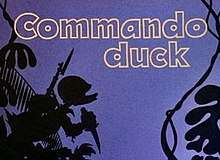Commando Duck
| Commando Duck | |
|---|---|
| Donald Duck series | |
 Title Card | |
| Directed by | Jack King |
| Produced by | Walt Disney |
| Voices by | Clarence Nash |
| Music by | Oliver Wallace |
| Studio | Walt Disney Productions |
| Distributed by | RKO Radio Pictures |
| Release date(s) | June 2, 1944 |
| Color process | Technicolor |
| Running time | 7 minutes |
| Language | English |
| Preceded by | Contrary Condor |
| Followed by | The Plastics Inventor |
Commando Duck is a Walt Disney cartoon starring Donald Duck. It was released on June 2, 1944 by RKO Radio Pictures.
Plot
Donald Duck parachutes into the jungle of a remote Pacific island to wipe out a Japanese airfield undetected.[1] [2] He loses most of his equipment in the process of landing- and is nearly eaten by a pair of crocodiles. He uses a rubber raft to travel down the river. He is located by Japanese snipers, including one disguised as a rock and one disguised as a slant-eyed and buck-toothed tree.[1] He initially mistakes their bullets for mosquitoes and presses onwards.[1]
His raft is caught beneath a waterfall and starts inflating. He makes sure the raft hits nothing that would pop it. When he gets to the edge of a cliff, he sees the airfield. The raft has already exploded, causing water to flow. This large amount of water splashes onto the airfield, wiping the whole thing clean, but leaving disfigured airplanes. Upon seeing the ruins of the airfield, a proud Donald declares his mission accomplished ("Contacted enemy, washed out same").[1]
Analysis
The cartoon expresses blatant anti-Japanese sentiment. However, the focus is mostly on Donald and his efforts and less on the racial aspects of the enemy. This has allowed the short to be broadcast to modern audiences with most of the Japanese references removed.[1]
There are Japanese caricatures and depictions of the Imperial Japanese Army. There is also a reference to Hirohito.[1] The Japanese soldiers speak in stereotypical dialect and advocate firing the first shot at a man's back.[2]
The gag with the enemy soldier disguised as a tree can be traced back to Shoulder Arms (1918). It was also used in A Lecture on Camouflage (1944).[3] It was later utilized by the Indians during their battle with the Lost Boys in the 1953 Disney animated feature Peter Pan as well.
Though earlier war-era shorts (e.g. Donald Gets Drafted, The Vanishing Private, etc.) depict Donald's experiences and training as a regular U.S. Army draftee and infantry private- the commando mission and Pacific Theater of Operations setting in this short are seemingly 6th Ranger Battalion or Paramarine/Marine Raider-inspired.[4]
This is the only film which depicts a regular Disney character engaging with the enemy at war.[5]
Sources
- Akita, Kimiko; Kenney, Rick (2013), "A "Vexing Implication": Siamese Cats and Orientalist Mischief-Making", in Cheu, Johnson, Diversity in Disney Films: Critical Essays on Race, Ethnicity, Gender, Sexuality and Disability, McFarland & Company, ISBN 978-0786446018
- Leskosky, Richard J. (2011), "Cartoons Will Win the War:World War II Propaganda Shorts", in Van Riper, Bowdoin, Learning from Mickey, Donald and Walt: Essays on Disney's Edutainment Films, McFarland & Company, ISBN 978-0786484751
- Shull, Michael S.; Wilt, David E. (2004), "Filmography 1944", Doing Their Bit: Wartime American Animated Short Films, 1939-1945, McFarland & Company, ISBN 978-0786481699
- Shull, Michael S.; Wilt, David E. (2004), "Private Snafu Cartoons", Doing Their Bit: Wartime American Animated Short Films, 1939-1945, McFarland & Company, ISBN 978-0786481699
References
- 1 2 3 4 5 6 Shull, Wilt (2004), p. 166
- 1 2 Akita, Kenney (2013), p. 53
- ↑ Shull, Wilt (2004), p. 193-194
- ↑ https://books.google.com/books?id=ZEeaBgAAQBAJ&pg=PA5&lpg=PA5&dq=paramarine+commandos&source=bl&ots=VPBDOjL9CK&sig=uKuxUeaf4dqsvzsv9_qwDIFXdGI&hl=en&sa=X&ved=0CB0Q6AEwAGoVChMIkb3eu46-yAIVgYINCh1GcAxr#v=onepage&q=paramarine%20commandos&f=false
- ↑ Leskosky (2011), p. 60
